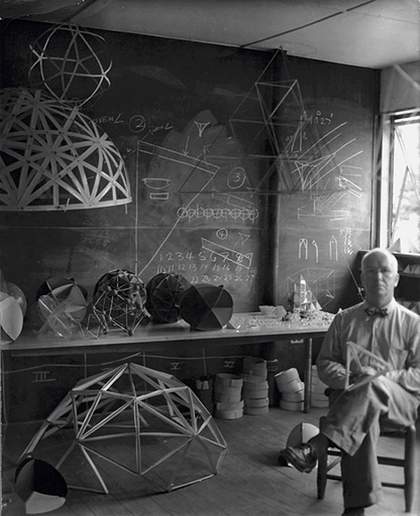
Buckminster Fuller in his classroom at Black Mountain College, photographed by Hazel Larson Archer, summer 1948
Courtesy Black Mountain College Museum & Arts Centre © Estate of Hazel Larson Archer
In the spring of 1949 a course by architect Buckminster Fuller presented students at the Institute of Design in Chicago with the problem, as apocalypse-cum-homework assignment: “The city is to be evacuated. All residential and industrial concentrations of 50,000 persons or more are in immediate danger of annihilation. Consumable goods now directed towards these areas will be diverted to smaller decentralised communities. Seven days are allowed in which to gather all living mechanics necessary to maintain a high standard of living for a family of six – two adults, two children, two guests. Everything not decentralised will be destroyed.”
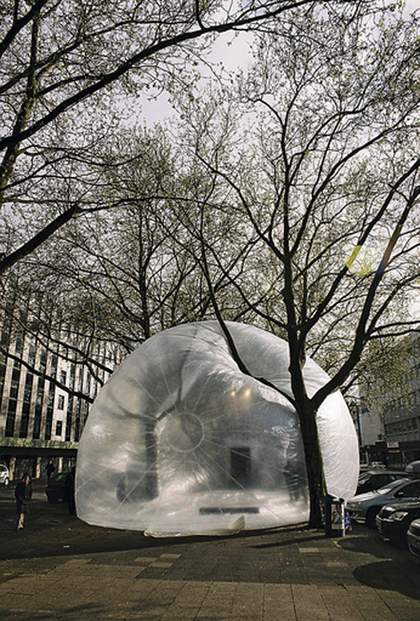
Pastique Fantastique and Raumlabor Berlin’s Das Küchenmonument in Duisburg, Germany, 2006
Courtesy Plastique Fantastique © Marco Canevacc
In the twenty-first century, many artists seem galvanised by Fuller’s charge, and often the works they produce appropriate his iconic geodesic dome designs as prototypes for catastrophe shelters. In New York alone in 2009 and 2010, one could encounter the Waterpod, a mobile domed barge project undertaken by artist Mary Mattingly in the vein of self-sustaining, closed-environment biosphere experiments; Michael Smith and Mike Kelley’s installation at Sculpture Centre in Queens exploring, among other 1960s counterculturederived baggage, the prevalence of domes at Burning Man events in the Nevada desert; Fritz Haeg’s aggregation of domes intended for squatting the hills north of Los Angeles, programmed with community-based workshops at X Initiative in the former Dia space in Chelsea; Nils Norman’s eerily abandoned geodesic and pup tent city on Governors Island; and Matthew Day Jackson’s installations of charred space capsules and tomb-like domes at Peter Blum Gallery’s two Manhattan locations. Is this resurgence of domes the dawn of a new age of “outlaw design”, as fans of Fuller predicted would be his future influence on alternative architecture in a 1997 book?
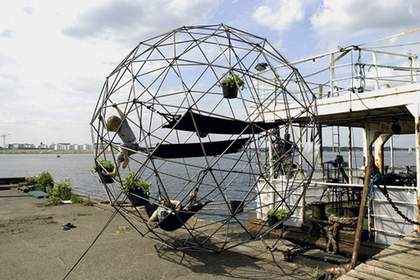
N55
Urban Free Habitat System 2008
Steel tubing, water tank, hammocks, plastic buckets
© N55
At first I thought that in recent Fuller-inspired art projects a marked shift had taken place in twenty-first-century quotations of the geodesic dome that distinguished them from many 1960s and 1970s incarnations. The difference between then and now: gone was the frontiersman logic of Arcadian, back-to-the-land, drop-off-the-grid, atomised micro-environmentalism; gone, too, was the technological euphoria about the consumption of appropriate “tools”. A new set of concerns seemed to come to the fore, sometimes in direct opposition to the ambitions of the earlier generation. What emerged instead is a return to issues that had been explored by radical collectives such as Ant Farm and Archigram, which were bent on politicising the technocratic, libertarian logic of Fuller’s theories: sculptural structures as temporary interventions in urban sites, as kiosk production and as shelter/ information display hybrids.
Domes continue to be important to artists as a form of improvised construction using recycled materials and for their multifunctionality as pavilions and gathering places for culture and communication. At the axis of alternative architecture and political art, artists working in this vein today speculate and experiment with a complex and often parallel set of issues: how to historicise the utopian imagination of the 1960s, and how to prototype ecological sustainability in sculptural form. These approaches concern access to shelter in a wider sociopolitical, rather than individual consumerist, sense and question the social responsibility of the artist for connecting art in public places to matters of civic concern.
This shift represents a battle to uncouple Fuller from his reputation as an apolitical technocrat who mistook as mere inefficiency the inequalities that result from capitalism’s logic of endless growth. Contemporary artists are interested in Fuller in order to return to his advocacy of a just redistribution of global resources, and his notion that architecture can be a key player in understanding and representing the management of those networked resources.
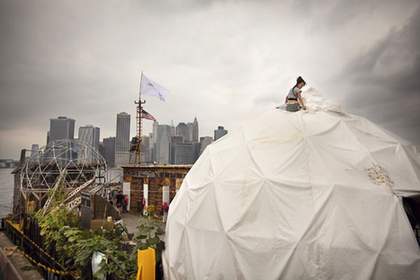
Mary Mattingly
Waterpod
Photographed by Michael Magle for the New York Times, 2009
Courtesy Michael Nagle © Mary Mattingly

US Marine Corps transporting a 55 ft dome via helicopter, 1954
Courtesy Whitney Museum of American Art © Estate of R Buckminster Fuller
In particular, artists such as Oscar Tuazon, Michael Rakowitz, Nils Norman and Marjetica Potrc have all used obvious references to homelessness and the unequal distribution of basic resources to the underprivileged in their work. Norman, in rethinking domes as hybrid structures – ones that double as shelters and as venues for information display – uses them as urban kiosks in an argument against eroding the public functions of the city street in the face of neoliberalism’s tendency to privatise and limit public exchange. In his case, the kind of information housed by the dome connects various historical struggles concerning the distribution of resources. For example, one project explores the connections between “free” stores undertaken by the San Francisco-based Diggers in the late 1960s and their mid-seventeenth-century forebears’ (and namesakes’) struggles against the privatisation of common land in Commonwealth England. Another proposed a pavilion as a hub for a speculative urban agricultural plan designed, among other things, to shelter social justice advocates from police. Tuazon constructs geodesic domes using cardboard boxes, scavenged from supermarkets and drugstores, bearing the logos of ubiquitous commodities. The City Without a Ghetto, as he terms the work, creates provisional spaces of shelter alluding to vernacular cardboard structures in marginal areas, while also producing sculptural installations in galleries that refer to the temporary and precarious housing of homeless populations.
Potrc, an architect working interdisciplinarily in art contexts, creates quick-construction domes out of recycled materials to be used as music festival shelters or bunker-like structures to upgrade traditional shanty town dwellings. Rakowitz produced inflatable dome structures that likewise reference problems of homelessness in city centres. His constructions of the late 1990s latched on to existing buildings’ heating and ventilation systems, creating parasitic temporary housing. In a project from 2003, he revisited the near-total destruction by fire of the 1967 Montreal Expo dome designed by Fuller and Shoji Sadao. He created a two-metre-high, tent-like model of the dome strung with mobiles of small coded semaphores and national flags. The piece connected protests against the Vietnam War upon Lyndon Johnson’s Expo visit in 1967 to Fuller’s paradoxical collaborations with educational institutions and the military, including the so-called Supine Dome at the progressive Black Mountain College in 1948 – his first failed attempt to erect a large-scale geodesic dome – shortly before a successful dome assembly on the lawn of the Pentagon garden in 1949.
In artist Molly Corey’s The Dome Project 2007, we can see how the optimism about domes as radical critiques of existing models of shelter design and resource management – and their particular suitability as do-it-yourself spaces – had been treated suspiciously as early as the 1960s and 1970s. She interviewed her parents and other founders of the rural Red Rockers commune in southern Colorado, who had built one of the world’s largest freestanding geodesic domes in 1968–9, and combined the audio track of these interviews with a series of silent home movies taken by members of the community during its 1968–72 heyday. Accompanying the film is an installation of a small cluster of miniature domes constructed from images of her own previous artworks and family photographs. In a moving segment of the film, Corey’s mother Mary reflects on how at first the very silhouette of the dome seemed to indicate a better, more promising future. But it was a future that in the end was available only provisionally to her white, upper-middle-class “drop out” peers. By the early 1970s, tensions in the community reflected the once politically progressive members’ discomfort with their increasing insularity from larger social politics.
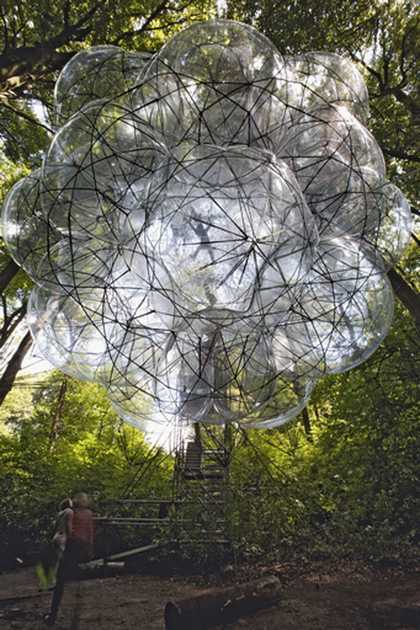
Tomas Saraceno
Flying Green House 2008
35 helium balloons, netting
Dimensions variable
Courtesy Tanya Bonakdar Gallery/Andersons Contemporary & Pink Summer Contemporary Art © Tomas Saraceno
In that vein Tuazon and I once discussed how the retreat from popular dome building in the 1980s had represented (yet another) rollback from the high-water mark of late 1960s utopianism, though perhaps only because this form of idealism (doyour- own-thing libertarianism) was itself a departure from the radical social justice demands of the New Left. We talked about how Lloyd Kahn, one of the editors of the Fuller-inspired Whole Earth Catalog and the author of the influential “how-to” Domebooks series, had by 1989 repudiated the euphoric claims about domes he had once espoused. “Inspired by Buckminster Fuller to work on solving ‘mankind’s’ housing problems,” Kahn wrote, he had once proselytised for domes. But by the late 1980s he mournfully concluded: “They don’t work… Domes weren’t practical, economical or aesthetically tolerable.” He hoped that in revising his previous position he could help others to illuminate the continuing fascination with domes by presenting future readers with “the results of an experimental voyage… the bitter and the sweet”.
But in following Fuller’s call for architecture responsive to catastrophe, as the projects I cited at the beginning of this piece seem to do, are we seeing a “bitter” side of the 1960s returning to art practices today? Fuller had originally argued his project of dome construction as a utopian one: his articulation of “total thinking” – what he termed “comprehensive, anticipatory design science” that tests traditional artistic and architectural forms in order to progress towards a utopia of efficiently managed resources. Probing his influence on art practice today, and understanding how his ideas of equitable resource management and holistic planning are received in the present, will always be mediated by his reception in the 1960s and 1970s.
The geodesic dome was one of the rare grass roots, DIY forms of the twentieth century: in its heyday, it was appropriated by many as an easy-tobuild and cheap modern alternative to traditional values, both social and architectural. Now, as domes are once again returned to public consciousness, this time almost exclusively in the work of contemporary artists, it seems crucial to ask why. For in recent years a sense of the dome as an exemplar of a new art of utopian public sculpture was abetted by projects such as those undertaken by Raumlabor Berlin, Minsuk Cho/Mass Studies, Tomas Saraceno, Haeg (in his earlier Los Angelesbased Sundown Salon) and Plastique Fantastique, among others, that used it more neutrally as an architecture of gathering places. Other, newer works – such as the Copenhagen-based collective N55’s Urban Free Habitat System (2008) and Walking House (2008) – likewise seemed to consider the political implications of shelter design as a topic of critical importance for artists by proposing nearly functional, yet ultimately quite farcical, prototypes of rolling domes or clumsy walking shelters, for example.
Yet disquieting elements colour a too-rosy interpretation of contemporary dome works as a new form of idealistic political art and urban intervention. Artists now return to Fuller for his Cassandra-like call to ecological responsibility. Domes are seen, much as Corey’s subjects eventually came to view them even during the “utopian” 1960s and 1970s, as dystopian architecture, spaces to begin society anew under threats of being rent by conflict and scarcity, and as a means to rescue the planet from bad stewardship, overconsumption and waste. Not to imply a causal relationship, but several factors seem important in considering this shift to a more pessimistic reception of Fuller. They include the calamitous political and infrastructural failure in the wake of Hurricane Katrina in 2005 and the ongoing housing crisis in the New Orleans region; the related problem of the increasing scientific evidence for and ineffective legislative response to global warming; and the near-total privatisation of once collectively owned natural resources that further troubles the feasibility of post-scarcity arguments.
Another side of Fuller has crept in: an urgency about nomadism in which improvised, off-the-grid shelters may become unavoidable features of a coming post-apocalyptic world. (This was evident even in Fuller and Shoji Sadao’s 1960 proposal to skin midtown Manhattan with a plastic dome, ostensibly to provide a controlled climate to economise on snow removal costs, but with an unavoidable implication that it could provide protection from nuclear fallout.) A sense of ecological catastrophe, both regional and global, permeates artists’ works today, as though the construction of alternative architectural forms such as domes becomes a prototype for emergency shelter.
